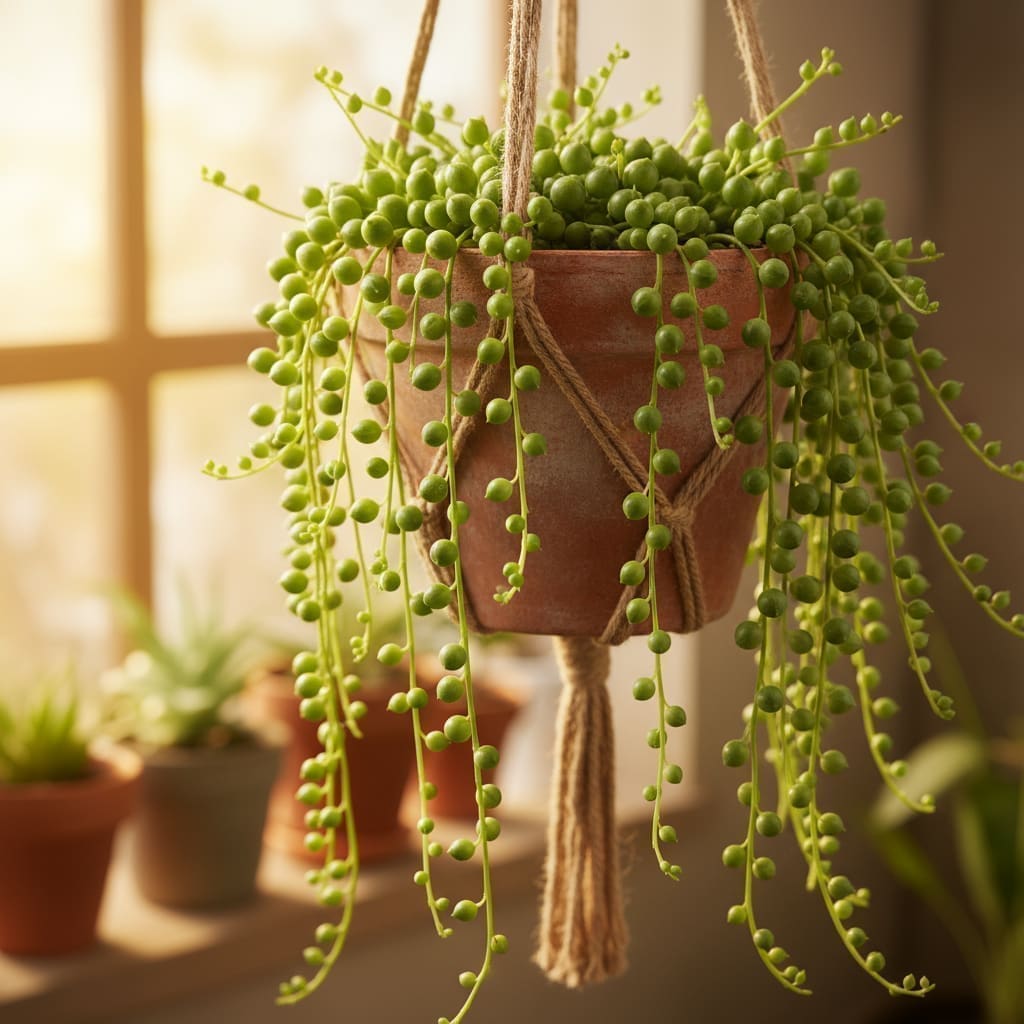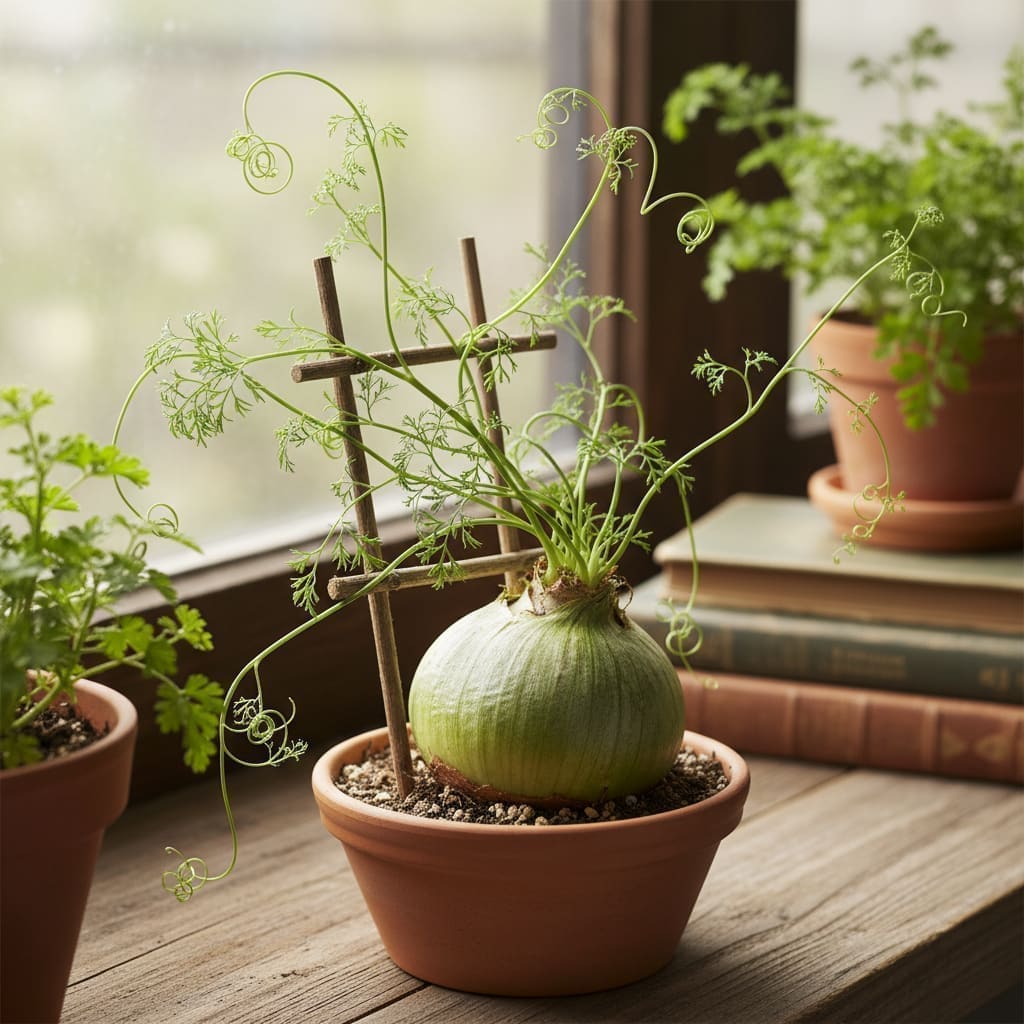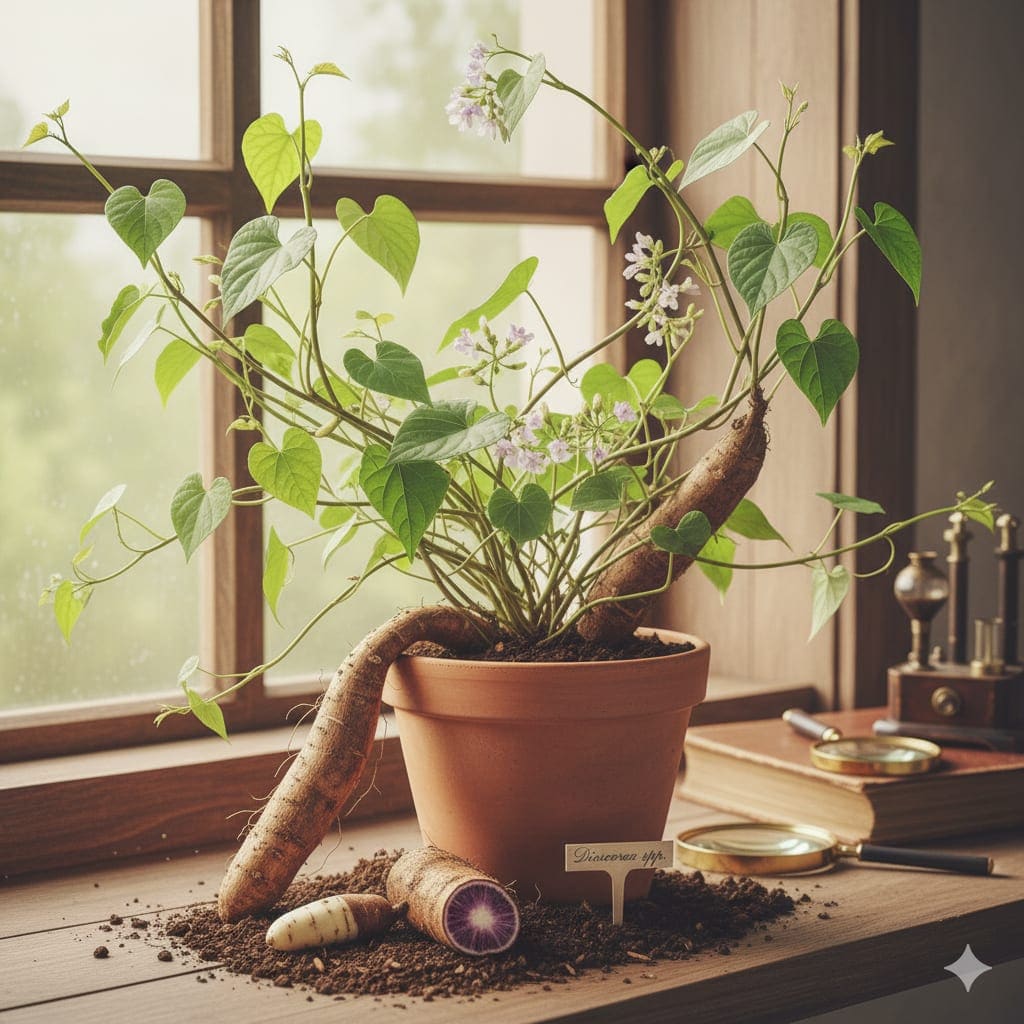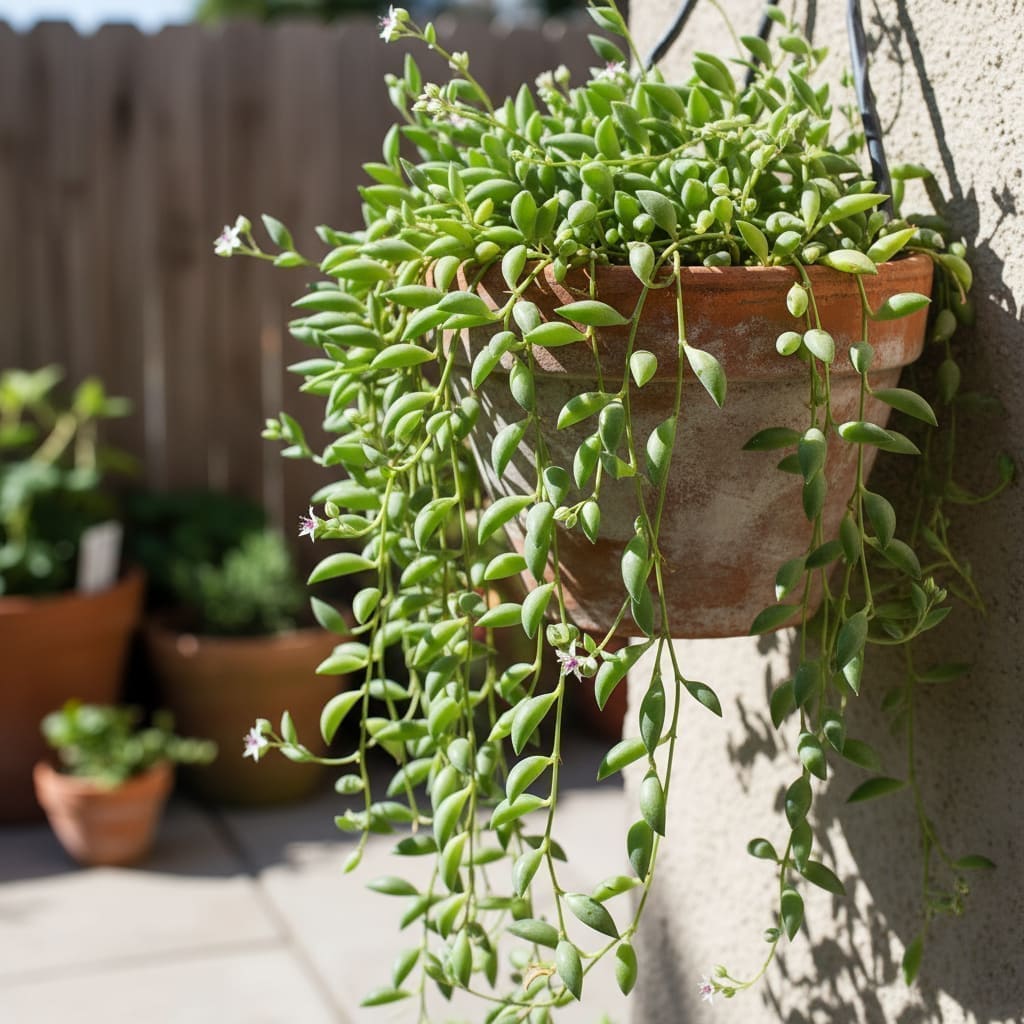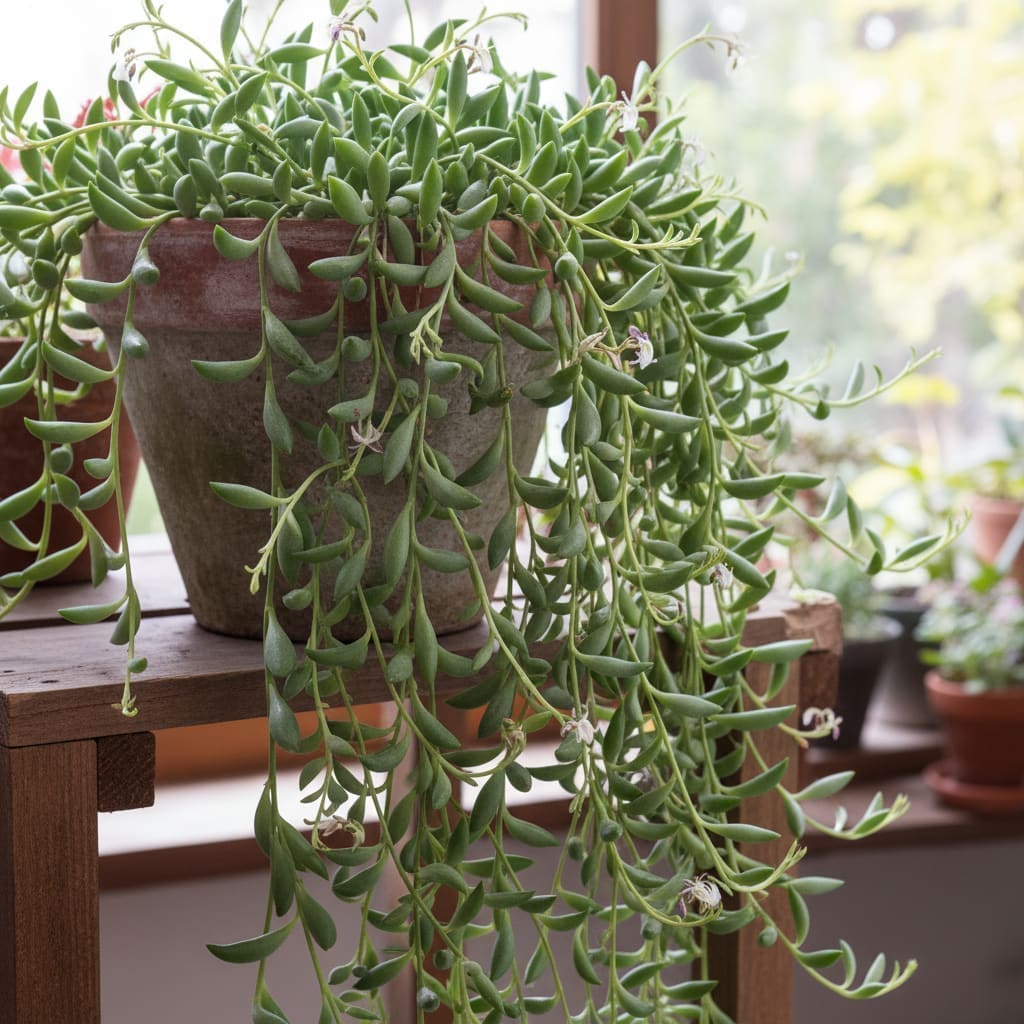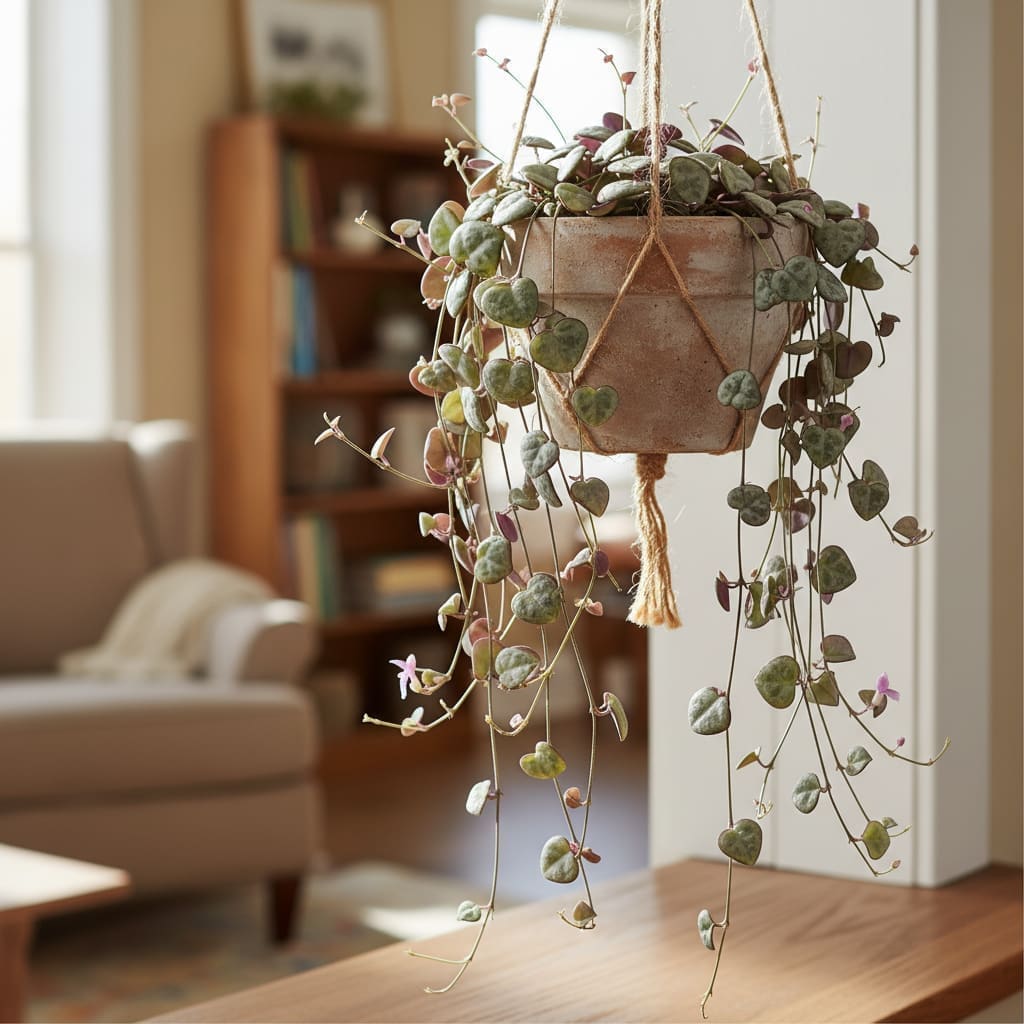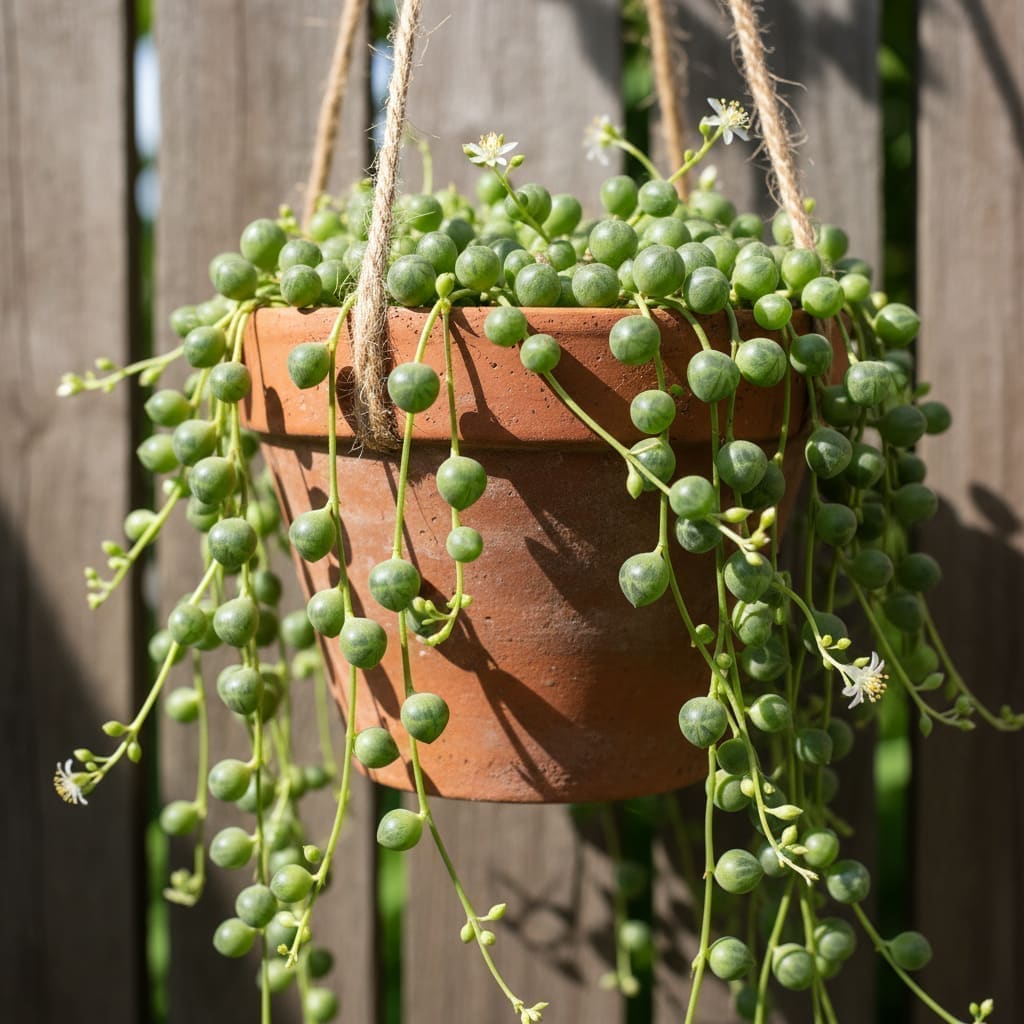String of Pearls (Curio rowleyanus) Care & Growing Guide
Overview
Curio rowleyanus, commonly known as String of Pearls, is a trailing succulent prized for its unique, bead-like foliage and cascading growth habit. Native to the Cape Provinces of South Africa, this plant has evolved to thrive in arid conditions, storing water in its spherical leaves to withstand drought. Its unusual form makes it a favorite for hanging baskets, shelves, and succulent arrangements.
In its natural habitat, String of Pearls sprawls along the ground or trails over rocks, rooting at nodes as it goes. Indoors, it is typically grown for its ornamental appeal and relatively low-maintenance requirements.
Identification & Growth Habit
String of Pearls is easily recognized by its small, round, pea-like leaves that grow along slender, trailing stems. Each leaf has a slight translucent line, known as an "epidermal window," which allows sunlight to penetrate deeper into the leaf for photosynthesis. Stems can grow several feet long under ideal conditions, creating a lush, cascading effect.
This species has a trailing growth habit but can also be trained to climb if given support, though it is most often displayed in hanging planters or elevated containers to showcase its draping stems.
Light & Placement
Provide bright, indirect light for optimal growth. An east-facing window with gentle morning sun is ideal, or place near a south-facing window filtered by sheer curtains. The plant can tolerate some direct morning sunlight but should be protected from intense midday or afternoon sun, which can scorch the leaves.
- Ideal placement: Near bright windows with filtered light.
- Avoid: Deep shade (causes leggy growth) and harsh midday sun.
Watering & Humidity
String of Pearls prefers infrequent but deep watering. Allow the soil to dry out completely between waterings. During the active growing season (spring and summer), water every 7–14 days, adjusting for your home's humidity and temperature. In winter, reduce watering to once every 3–4 weeks.
- If leaves begin to flatten, the plant may need more water.
- Use the "soak and dry" method to prevent root rot.
This plant thrives in low-humidity environments, making it well-suited to typical indoor air. Avoid overly humid rooms like bathrooms or kitchens, which can increase the risk of fungal issues.
Soil & Repotting
Use a well-draining succulent or cactus soil mix, ideally with a sandy, gritty composition. Good drainage is essential to prevent root rot. Always choose a pot with ample drainage holes.
Repot every 2–3 years or when the plant becomes root-bound, preferably in spring. Handle stems gently to avoid breakage during repotting.
Fertilizing
Feed biweekly during the growing season with a balanced, water-soluble fertilizer diluted to half strength. In winter, when the plant is dormant, reduce feeding to once every six weeks. Overfertilizing can lead to weak, leggy growth.
Pruning & Training
Prune to maintain shape, encourage fuller growth, and remove any dead or shriveled stems. Use clean, sharp scissors or pruning shears.
Training
- Trellis: Though naturally trailing, stems can be gently wound around a small trellis for a unique display.
- Moss pole: Less common for this species, but possible if stems are secured with soft ties.
Propagation (Step-by-Step)
- Select a healthy stem with plump leaves.
- Cut a 4–6 inch section using clean scissors.
- Allow the cut end to callus over for 1–2 days in a dry, shaded spot.
- Lay the cutting on top of moist succulent soil, pressing nodes gently into the surface.
- Keep soil lightly moist (not wet) until roots develop, usually in 2–3 weeks.
- Once established, care for as a mature plant.
Common Problems
Pests
- Mealybugs: Appear as white cottony spots; treat with insecticidal soap or neem oil.
- Aphids: Small green or black insects; rinse off with water or apply horticultural oil.
Diseases
- Root rot: Caused by overwatering; remove affected roots and repot in fresh, dry soil.
- Fungal spots: Often due to high humidity; improve air circulation and reduce moisture on leaves.
Toxicity & Pet Safety
String of Pearls is toxic if ingested by humans or pets. Keep out of reach of children, cats, and dogs. Symptoms of ingestion may include gastrointestinal distress. Seek veterinary assistance if a pet consumes the plant.
Styling & Decor Tips
- Display in hanging baskets to showcase long, draping stems.
- Place on high shelves or plant stands for a cascading effect.
- Combine with other succulents in mixed arrangements for textural contrast.
Varieties & Cultivars
While Curio rowleyanus is the most common, related species such as Curio herreanus (String of Watermelons) and Curio radicans (String of Bananas) offer similar care requirements with different leaf shapes.
Buying Tips & Maturity
When purchasing, look for plants with firm, plump leaves and no signs of shriveling or discoloration. Avoid specimens with mushy stems or visible pests. Mature plants may have stems several feet long, while younger plants will be shorter and less full.
Seasonal Care
- Spring/Summer: Active growth; water regularly (allowing soil to dry between waterings), fertilize biweekly, and provide bright light.
- Autumn: Begin reducing watering and feeding as growth slows.
- Winter: Dormant period; water sparingly and keep in cooler temperatures (50–60°F).
FAQ
- How fast does String of Pearls grow? In ideal conditions, it can grow several inches per month during the active season.
- Can String of Pearls grow outdoors? Yes, in frost-free climates with bright, indirect light and well-draining soil.
- Why are my pearls shriveling? Likely due to underwatering or root issues; check soil moisture and root health.
- Do they flower? Yes, small white flowers with a cinnamon-like scent may appear in late winter or spring under the right conditions.
- Can I root cuttings in water? It is possible, but rooting in soil is generally more successful for this species.
Sources: Wikipedia, The Spruce
Troubleshooting Scenarios
- Leggy growth with large gaps between pearls: Indicates insufficient light; move to a brighter location or supplement with a grow light.
- Sudden stem collapse: Often due to severe root rot; unpot immediately, trim away all mushy tissue, and re-root healthy cuttings in fresh soil.
- Brown, crispy leaf tips: Can result from prolonged drought or excessive direct sun; adjust watering schedule and light exposure.
- Yellowing pearls near soil line: May be caused by overwatering or poor airflow; improve drainage and increase ventilation.
Advanced Pruning & Training Techniques
For a denser display, pinch back stem tips during active growth to encourage branching. You can weave trimmed stems back into the pot’s surface to fill bare spots. For a living curtain effect, mount multiple plants in a row of wall planters and allow stems to intermingle. Experiment with circular or spiral forms by loosely coiling stems on a flat trellis.
Companion Plant Ideas
- Burro’s Tail (Sedum morganianum): Complements with similar trailing habit but contrasting leaf shape.
- String of Hearts (Ceropegia woodii): Adds delicate variegation and heart-shaped foliage for textural variety.
- Air Plants (Tillandsia spp.): Can be nestled among pearls for a low-maintenance mixed display.
- Miniature Cacti: Provide upright structure and variation in form within the same container.
Do & Don’t List
- Do: Rotate the pot periodically to ensure even light exposure.
- Do: Use a breathable pot material like terracotta to help prevent excess moisture retention.
- Don’t: Mist the pearls frequently; surface moisture can promote fungal issues.
- Don’t: Place directly against cold window glass in winter, as chilling injury may occur.
